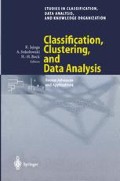Abstract
A new graph theoretical method is introduced to analyze a data set of objects described by a dissimilarity matrix d ij . This method is based on the generation of a series of random walks in the data set. We define a random walk in a data set by moving in each time step from one object to another one at random. In order that the random walk depends on the pattern of the data, a restriction depending on the previous moves is imposed during its generation, so that the random walk is attracted by clusters formed of similar objects. We define a hierarchical set of graphs consisting of all connections of a series of random walks at a certain time step to detect the structure of the data and to derive an similarity measure between the objects. In an example an application of the method is shown.
Access this chapter
Tax calculation will be finalised at checkout
Purchases are for personal use only
Preview
Unable to display preview. Download preview PDF.
References
ALPERT, C.J. and KAHNG, A.B. (1993): Geometric embedding for faster (and better) multi-way netlist partitioning. In: Proceedings of the ACM/IEEE Design Automation Conference, 743–748.
BAILEY, T.A. and DUBES, R. (1982): Cluster validity profiles. Pattern Recognition, 15 (2), 61–83.
BEHZAD, M. and CHARTRAND, G. (1971): Introduction to the theory of graphs. Allyn and Bacon Inc., Boston.
BOBISUD, H.M. and BOBISUD, L.E. (1972): A metric for classifications. Taxon, 21, 607–613.
BOCK, H.-H. (1996): Probalistic models in cluster analysis. Computational Statistics Data Analysis, 23, 5–28.
BOLLOBAS, B. (1985): Random Graphs. Academic Press, London.
GODEHARDT, E. (1990): Graphs as structural models: the application of graphs and multigraphs in cluster anaysis. Advances in system analysis 4. Vieweg, Braunschweig, 2nd edition.
GORDON, A.D. (1999): Classification. Chapman Hall, 2nd edition.
HAGEN, L. and KAHNG, A.B. (1992): A New Approach to Effective Circuit Clustering. In: Proceedings of the IEEE Intl. Conf. on Computer-Aided Design,422–427.
LING, R.F. (1973): A probability theory of cluster analysis. J. Am. Stat. Assoc., 68, 159–164.
SCHOLL, J. and PASCHINGER, E. (2001): Classification by restricted random walks. Pattern Recognition, accepted.
ZAHN, C.T. (1971): Graph-theoretical methods for detecting and describing gestalt clusters. IEEE Trans.Comp, C-20(1), 68–86.
Author information
Authors and Affiliations
Editor information
Editors and Affiliations
Rights and permissions
Copyright information
© 2002 Springer-Verlag Berlin Heidelberg
About this paper
Cite this paper
Schöll, J., Paschinger, E. (2002). Cluster Analysis by Restricted Random Walks. In: Jajuga, K., Sokołowski, A., Bock, HH. (eds) Classification, Clustering, and Data Analysis. Studies in Classification, Data Analysis, and Knowledge Organization. Springer, Berlin, Heidelberg. https://doi.org/10.1007/978-3-642-56181-8_12
Download citation
DOI: https://doi.org/10.1007/978-3-642-56181-8_12
Publisher Name: Springer, Berlin, Heidelberg
Print ISBN: 978-3-540-43691-1
Online ISBN: 978-3-642-56181-8
eBook Packages: Springer Book Archive

